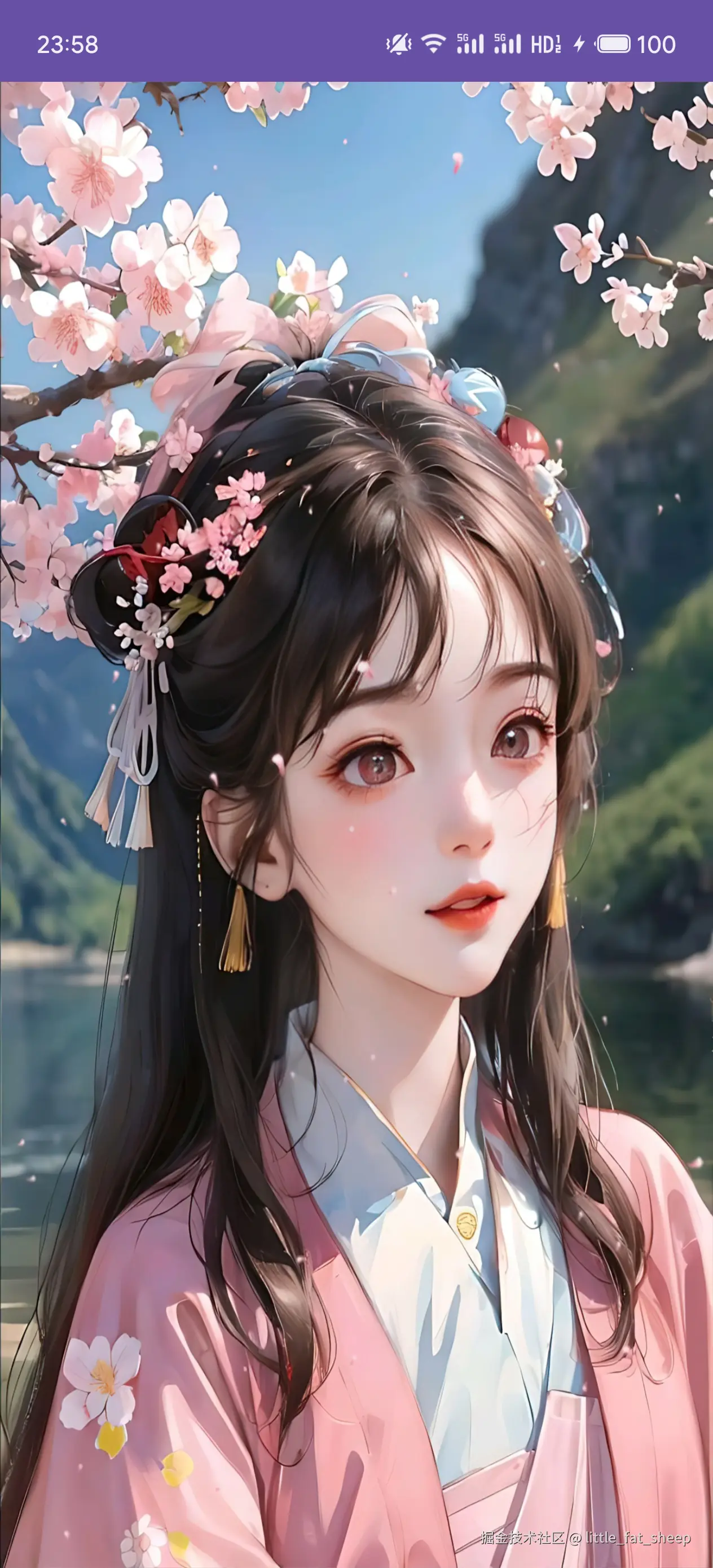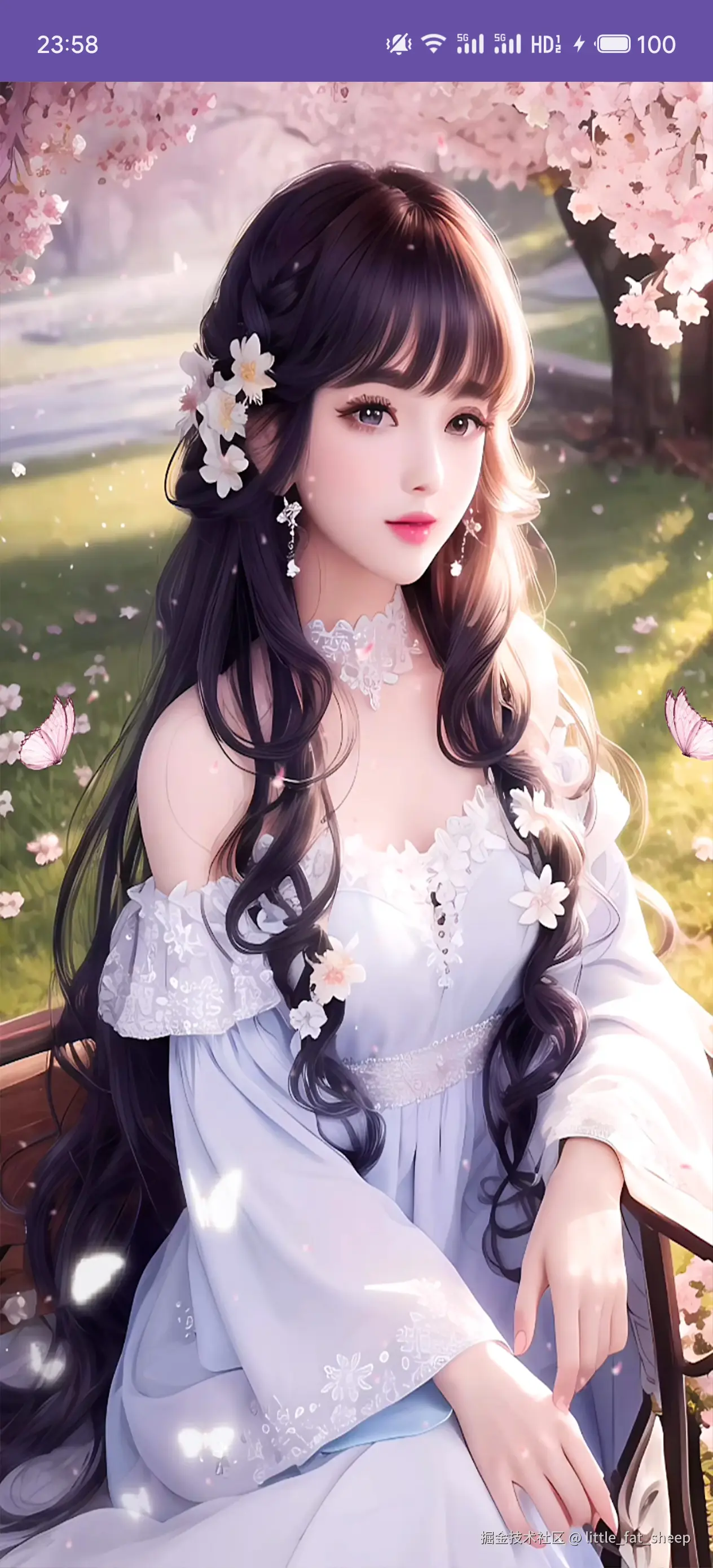1 前言
Android 中,GLSurfaceView 封装了 EGL 环境,使得我们省去了复杂的 EGL 环境搭建。如果我们不用 GLSurfaceView,该如何渲染 OpenGL ES 图像?在回答此问题前,我们先了解下 EGL。
EGL 是 Khronos Group 定义的平台无关接口,作为 OpenGL ES 和本地窗口系统之间的桥梁,主要功能如下。
- 管理图形上下文
- 创建和管理渲染表面 (surface)
- 同步渲染与平台显示系统
EGL 提供了两种渲染方式,分别是离屏渲染和窗口渲染,分别对应 eglCreatePbufferSurface 和 eglCreateWindowSurface。对于离屏渲染方案,详见 → EGL+FBO离屏渲染。eglCreateWindowSurface 函数的源码如下。
cpp
public static EGLSurface eglCreateWindowSurface(EGLDisplay dpy,
EGLConfig config, Object win, int[] attrib_list, int offset){
Surface sur = null;
if (win instanceof SurfaceView) {
SurfaceView surfaceView = (SurfaceView)win;
sur = surfaceView.getHolder().getSurface();
} else if (win instanceof SurfaceHolder) {
SurfaceHolder holder = (SurfaceHolder)win;
sur = holder.getSurface();
} else if (win instanceof Surface) {
sur = (Surface) win;
}
EGLSurface surface;
if (sur != null) {
surface = _eglCreateWindowSurface(dpy, config, sur, attrib_list, offset);
} else if (win instanceof SurfaceTexture) {
surface = _eglCreateWindowSurfaceTexture(dpy, config,
win, attrib_list, offset);
} else {
throw new java.lang.UnsupportedOperationException(
"eglCreateWindowSurface() can only be called with an instance of " +
"Surface, SurfaceView, SurfaceTexture or SurfaceHolder at the moment, " +
"this will be fixed later.");
}
return surface;
} 主要留意 win 参数,可以看到它可以是 SurfaceView、SurfaceHolder、Surface,本质都是为了获取 Surface。因此我们提供了以下两种渲染图像的方案。
- 继承 SurfaceView 方案:自定义一个 View 继承 SurfaceView,并实现 SurfaceHolder.Callback 接口,在 surfaceCreated 方法中将 this 或 getHolder() 传给 eglCreateWindowSurface 函数。
- 继承 TextureView 方案:自定义一个 View 继承 TextureView,并实现 TextureView.SurfaceTextureListener 接口,在 onSurfaceTextureAvailable 方法中会提供 SurfaceTexture,我们可以创建一个 Surface,并将 SurfaceTexture 传给 Surface,然后将创建的 Surface 传给 eglCreateWindowSurface 函数。
本文完整代码详见 → 不用GLSurfaceView,如何渲染图像。
2 继承 SurfaceView 方案
自定义一个 View 继承 SurfaceView,并实现 SurfaceHolder.Callback 接口,在 surfaceCreated 方法中将 this 或 getHolder() 传给 eglCreateWindowSurface 函数。
由于 GLSurfaceView 继承 SurfaceView,所以该方案很容易想到,只需要将 GLSurfaceView 的核心代码扣出来就行。
MainActivity.java
java
package com.zhyan8.egldemo;
import android.os.Bundle;
import androidx.appcompat.app.AppCompatActivity;
public class MainActivity extends AppCompatActivity {
private EGLSurfaceView mEglSurfaceView;
protected void onCreate(Bundle savedInstanceState) {
super.onCreate(savedInstanceState);
mEglSurfaceView = new EGLSurfaceView(this);
setContentView(mEglSurfaceView);
mEglSurfaceView.setRenderer(new MyRenderer(this));
}
@Override
protected void onResume() {
super.onResume();
mEglSurfaceView.requestRender();
//mEglSurfaceView.startRender();
}
@Override
protected void onPause() {
super.onPause();
mEglSurfaceView.stopRender();
}
} EGLSurfaceView.java
java
package com.zhyan8.egldemo;
import android.content.Context;
import android.opengl.EGL14;
import android.opengl.EGLConfig;
import android.opengl.EGLContext;
import android.opengl.EGLDisplay;
import android.opengl.EGLExt;
import android.opengl.EGLSurface;
import android.util.Log;
import android.view.Choreographer;
import android.view.SurfaceHolder;
import android.view.SurfaceView;
import androidx.annotation.NonNull;
/**
* @author little fat sheep
* 承载EGL环境的View, 类比GLSurfaceView
*/
public class EGLSurfaceView extends SurfaceView implements SurfaceHolder.Callback {
private static final String TAG = "EGLSurfaceView";
protected EGLDisplay mEGLDisplay;
protected EGLConfig mEGLConfig;
protected EGLContext mEGLContext;
protected EGLSurface mEGLSurface;
protected Context mContext;
protected Renderer mRenderer;
protected boolean mFirstCreateSurface = true;
private Choreographer mChoreographer = Choreographer.getInstance();
public EGLSurfaceView(Context context) {
super(context);
mContext = context;
getHolder().addCallback(this);
}
// 设置渲染器
public void setRenderer(Renderer renderer) {
mRenderer = renderer;
}
// 开始持续渲染
public void startRender() {
Log.i(TAG, "startRender");
mChoreographer.removeFrameCallback(mFrameCallback);
mChoreographer.postFrameCallback(mFrameCallback);
}
// 暂停持续渲染
public void stopRender() {
Log.i(TAG, "stopRender");
mChoreographer.removeFrameCallback(mFrameCallback);
}
// 请求渲染一帧
public void requestRender() {
mFrameCallback.doFrame(System.nanoTime());
}
@Override
protected void onAttachedToWindow() {
super.onAttachedToWindow();
createDisplay();
createConfig();
createContext();
}
@Override
public void surfaceCreated(@NonNull SurfaceHolder holder) { // 每次activity resume都会调用一次
Log.i(TAG, "surfaceCreated, surface=" + holder.getSurface());
createSurface();
makeCurrent();
if (mFirstCreateSurface) {
mRenderer.onSurfaceCreated();
mFirstCreateSurface = false;
}
}
@Override
public void surfaceChanged(@NonNull SurfaceHolder holder, int format, int width, int height) {
Log.i(TAG, "surfaceChanged, width=" + width + ", height=" + height);
mRenderer.onSurfaceChanged(width, height);
}
@Override
public void surfaceDestroyed(@NonNull SurfaceHolder holder) { // 每次activity pause都会调用一次
Log.i(TAG, "surfaceDestroyed");
if (mEGLDisplay != null && mEGLDisplay != EGL14.EGL_NO_DISPLAY) {
// 与显示设备解绑
EGL14.eglMakeCurrent(mEGLDisplay, EGL14.EGL_NO_SURFACE, EGL14.EGL_NO_SURFACE, EGL14.EGL_NO_CONTEXT);
// 销毁 EGLSurface
if (mEGLSurface != null && mEGLSurface != EGL14.EGL_NO_SURFACE) {
EGL14.eglDestroySurface(mEGLDisplay, mEGLSurface);
checkoutConfig("eglDestroySurface");
mEGLSurface = null;
}
}
}
@Override
public void onDetachedFromWindow() {
super.onDetachedFromWindow();
Log.i(TAG, "onDetachedFromWindow");
stopRender();
getHolder().removeCallback(this);
if (mEGLDisplay != null && mEGLDisplay != EGL14.EGL_NO_DISPLAY) {
// 与显示设备解绑
EGL14.eglMakeCurrent(mEGLDisplay, EGL14.EGL_NO_SURFACE, EGL14.EGL_NO_SURFACE, EGL14.EGL_NO_CONTEXT);
// 销毁 EGLSurface
if (mEGLSurface != null && mEGLSurface != EGL14.EGL_NO_SURFACE) {
EGL14.eglDestroySurface(mEGLDisplay, mEGLSurface);
checkoutConfig("eglDestroySurface");
mEGLSurface = null;
}
// 销毁 EGLContext
if (mEGLContext != null && mEGLContext != EGL14.EGL_NO_CONTEXT) {
EGL14.eglDestroyContext(mEGLDisplay, mEGLContext);
checkoutConfig("eglDestroyContext");
mEGLContext = null;
}
// 销毁 EGLDisplay (显示设备)
EGL14.eglTerminate(mEGLDisplay);
checkoutConfig("eglTerminate");
mEGLDisplay = null;
}
}
// 1.创建EGLDisplay
private void createDisplay() {
mEGLDisplay = EGL14.eglGetDisplay(EGL14.EGL_DEFAULT_DISPLAY);
int[] versions = new int[2];
EGL14.eglInitialize(mEGLDisplay, versions,0, versions, 1);
checkoutConfig("eglInitialize");
}
// 2.创建EGLConfig
private void createConfig() {
if (mEGLDisplay != null && mEGLDisplay != EGL14.EGL_NO_DISPLAY) {
EGLConfig[] configs = new EGLConfig[1];
int[] configNum = new int[1];
EGL14.eglChooseConfig(mEGLDisplay, mEGLConfigAttrs, 0, configs, 0,1, configNum, 0);
if (configNum[0] > 0) {
mEGLConfig = configs[0];
}
checkoutConfig("eglChooseConfig");
}
}
// 3.创建EGLContext
private void createContext() {
if (mEGLConfig != null) {
mEGLContext = EGL14.eglCreateContext(mEGLDisplay, mEGLConfig, EGL14.EGL_NO_CONTEXT, mEGLContextAttrs, 0);
checkoutConfig("eglCreateContext");
}
}
// 4.创建EGLSurface
private void createSurface() {
if (mEGLContext != null && mEGLContext != EGL14.EGL_NO_CONTEXT) {
int[] eglSurfaceAttrs = { EGL14.EGL_NONE };
//mEGLSurface = EGL14.eglCreateWindowSurface(mEGLDisplay, mEGLConfig, getHolder(), eglSurfaceAttrs, 0);
mEGLSurface = EGL14.eglCreateWindowSurface(mEGLDisplay, mEGLConfig, this, eglSurfaceAttrs, 0);
checkoutConfig("eglCreateWindowSurface");
}
}
// 5.绑定EGLSurface和EGLContext到显示设备(EGLDisplay)
private void makeCurrent() {
if (mEGLSurface != null && mEGLSurface != EGL14.EGL_NO_SURFACE) {
EGL14.eglMakeCurrent(mEGLDisplay, mEGLSurface, mEGLSurface, mEGLContext);
checkoutConfig("eglMakeCurrent");
}
}
private void checkoutConfig(String tag) {
int error = EGL14.eglGetError();
if (error != EGL14.EGL_SUCCESS) {
Log.e(TAG, tag + " error=0x" + Integer.toHexString(error));
}
}
// EGLConfig参数
private int[] mEGLConfigAttrs = {
EGL14.EGL_RED_SIZE, 8,
EGL14.EGL_GREEN_SIZE, 8,
EGL14.EGL_BLUE_SIZE, 8,
EGL14.EGL_ALPHA_SIZE, 8,
EGL14.EGL_DEPTH_SIZE, 8,
//EGL14.EGL_RENDERABLE_TYPE, EGL14.EGL_OPENGL_ES2_BIT,
EGL14.EGL_RENDERABLE_TYPE, EGLExt.EGL_OPENGL_ES3_BIT_KHR,
EGL14.EGL_NONE
};
// EGLContext参数
private int[] mEGLContextAttrs = {
EGL14.EGL_CONTEXT_CLIENT_VERSION, 3,
EGL14.EGL_NONE
};
Choreographer.FrameCallback mFrameCallback = new Choreographer.FrameCallback() {
@Override
public void doFrame(long frameTimeNanos) {
mChoreographer.postFrameCallback(mFrameCallback);
if (mEGLSurface != null) {
mRenderer.onDrawFrame();
EGL14.eglSwapBuffers(mEGLDisplay, mEGLSurface);
checkoutConfig("eglSwapBuffers");
}
}
};
/**
* @author little fat sheep
* 渲染器接口, 类比GLSurfaceView.Renderer
*/
interface Renderer {
void onSurfaceCreated();
void onSurfaceChanged(int width, int height);
void onDrawFrame();
}
} MyRenderer.java
java
package com.zhyan8.egldemo;
import android.content.Context;
import android.opengl.GLES30;
import java.nio.FloatBuffer;
public class MyRenderer implements EGLSurfaceView.Renderer {
private FloatBuffer vertexBuffer;
private FloatBuffer textureBuffer;
private MyGLUtils mGLUtils;
private int mTextureId;
public MyRenderer(Context context) {
mGLUtils = new MyGLUtils(context);
getFloatBuffer();
}
@Override
public void onSurfaceCreated() {
//设置背景颜色
GLES30.glClearColor(0.1f, 0.2f, 0.3f, 0.4f);
//编译着色器
final int vertexShaderId = mGLUtils.compileShader(GLES30.GL_VERTEX_SHADER, R.raw.vertex_shader);
final int fragmentShaderId = mGLUtils.compileShader(GLES30.GL_FRAGMENT_SHADER, R.raw.fragment_shader);
//链接程序片段
int programId = mGLUtils.linkProgram(vertexShaderId, fragmentShaderId);
GLES30.glUseProgram(programId);
mTextureId = mGLUtils.loadTexture(R.raw.girl);
}
@Override
public void onSurfaceChanged(int width, int height) {
//设置视图窗口
GLES30.glViewport(0, 0, width, height);
}
@Override
public void onDrawFrame() {
//将颜色缓冲区设置为预设的颜色
GLES30.glClear(GLES30.GL_COLOR_BUFFER_BIT);
//启用顶点的数组句柄
GLES30.glEnableVertexAttribArray(0);
GLES30.glEnableVertexAttribArray(1);
//准备顶点坐标和纹理坐标
GLES30.glVertexAttribPointer(0, 3, GLES30.GL_FLOAT, false, 0, vertexBuffer);
GLES30.glVertexAttribPointer(1, 2, GLES30.GL_FLOAT, false, 0, textureBuffer);
//激活纹理
GLES30.glActiveTexture(GLES30.GL_TEXTURE);
//绑定纹理
GLES30.glBindTexture(GLES30.GL_TEXTURE_2D, mTextureId);
//绘制贴图
GLES30.glDrawArrays(GLES30.GL_TRIANGLE_FAN, 0, 4);
//禁止顶点数组句柄
GLES30.glDisableVertexAttribArray(0);
GLES30.glDisableVertexAttribArray(1);
}
private void getFloatBuffer() {
float[] vertex = new float[] {
1f, 1f, 0f, //V0
-1f, 1f, 0f, //V1
-1f, -1f, 0f, //V2
1f, -1f, 0f //V3
};
float[] texture = {
1f, 0f, //V0
0f, 0f, //V1
0f, 1.0f, //V2
1f, 1.0f //V3
};
vertexBuffer = mGLUtils.getFloatBuffer(vertex);
textureBuffer = mGLUtils.getFloatBuffer(texture);
}
} MyGLUtils.java
java
package com.zhyan8.egldemo;
import android.content.Context;
import android.graphics.Bitmap;
import android.graphics.BitmapFactory;
import android.opengl.GLES30;
import android.opengl.GLUtils;
import java.io.BufferedReader;
import java.io.InputStream;
import java.io.InputStreamReader;
import java.nio.ByteBuffer;
import java.nio.ByteOrder;
import java.nio.FloatBuffer;
public class MyGLUtils {
private Context mContext;
private Bitmap mBitmap;
public MyGLUtils(Context context) {
mContext = context;
}
public FloatBuffer getFloatBuffer(float[] floatArr) {
FloatBuffer fb = ByteBuffer.allocateDirect(floatArr.length * Float.BYTES)
.order(ByteOrder.nativeOrder())
.asFloatBuffer();
fb.put(floatArr);
fb.position(0);
return fb;
}
//通过代码片段编译着色器
public int compileShader(int type, String shaderCode){
int shader = GLES30.glCreateShader(type);
GLES30.glShaderSource(shader, shaderCode);
GLES30.glCompileShader(shader);
return shader;
}
//通过外部资源编译着色器
public int compileShader(int type, int shaderId){
String shaderCode = readShaderFromResource(shaderId);
return compileShader(type, shaderCode);
}
//链接到着色器
public int linkProgram(int vertexShaderId, int fragmentShaderId) {
final int programId = GLES30.glCreateProgram();
//将顶点着色器加入到程序
GLES30.glAttachShader(programId, vertexShaderId);
//将片元着色器加入到程序
GLES30.glAttachShader(programId, fragmentShaderId);
//链接着色器程序
GLES30.glLinkProgram(programId);
return programId;
}
//从shader文件读出字符串
private String readShaderFromResource(int shaderId) {
InputStream is = mContext.getResources().openRawResource(shaderId);
BufferedReader br = new BufferedReader(new InputStreamReader(is));
String line;
StringBuilder sb = new StringBuilder();
try {
while ((line = br.readLine()) != null) {
sb.append(line);
sb.append("\n");
}
br.close();
} catch (Exception e) {
e.printStackTrace();
}
return sb.toString();
}
//加载纹理贴图
public int loadTexture(int resourceId) {
BitmapFactory.Options options = new BitmapFactory.Options();
options.inScaled = false;
mBitmap = BitmapFactory.decodeResource(mContext.getResources(), resourceId, options);
final int[] textureIds = new int[1];
// 生成纹理id
GLES30.glGenTextures(1, textureIds, 0);
// 绑定纹理到OpenGL
GLES30.glBindTexture(GLES30.GL_TEXTURE_2D, textureIds[0]);
GLES30.glTexParameteri(GLES30.GL_TEXTURE_2D, GLES30.GL_TEXTURE_MIN_FILTER, GLES30.GL_LINEAR_MIPMAP_LINEAR);
GLES30.glTexParameteri(GLES30.GL_TEXTURE_2D, GLES30.GL_TEXTURE_MAG_FILTER, GLES30.GL_LINEAR);
// 加载bitmap到纹理中
GLUtils.texImage2D(GLES30.GL_TEXTURE_2D, 0, mBitmap, 0);
// 生成MIP贴图
GLES30.glGenerateMipmap(GLES30.GL_TEXTURE_2D);
// 取消绑定纹理
GLES30.glBindTexture(GLES30.GL_TEXTURE_2D, 0);
return textureIds[0];
}
} vertex_shader.glsl
cpp
attribute vec4 a_position;
attribute vec2 a_texCoord;
varying vec2 v_texCoord;
void main() {
gl_Position = a_position;
v_texCoord = a_texCoord;
} fragment_shader.glsl
cpp
precision mediump float;
uniform sampler2D u_texture;
varying vec2 v_texCoord;
void main() {
gl_FragColor = texture2D(u_texture, v_texCoord);
} 运行效果如下。

3 继承 TextureView 方案
自定义一个 View 继承 TextureView,并实现 TextureView.SurfaceTextureListener 接口,在 onSurfaceTextureAvailable 方法中会提供 SurfaceTexture,我们可以创建一个 Surface,并将 SurfaceTexture 传给 Surface,然后将创建的 Surface 传给 eglCreateWindowSurface 函数。
前段时间在看 Rive 的源码,详见 → rive-android源码分析,了解到 Rive 底层是通过 OpenGL ES 渲染图像,并且也没有使用 GLSurfaceView,由此借鉴而来。该方案主要参考 Rive 中 RiveTextureView 的实现,eglCreateWindowSurface 参考 thread_state_egl.cpp。
与第二节相比,只有 EGLSurfaceView 类有差异,因此本节仅展示 EGLSurfaceView 的代码。
EGLSurfaceView.java
java
package com.zhyan8.egldemo;
import android.content.Context;
import android.graphics.SurfaceTexture;
import android.opengl.EGL14;
import android.opengl.EGLConfig;
import android.opengl.EGLContext;
import android.opengl.EGLDisplay;
import android.opengl.EGLExt;
import android.opengl.EGLSurface;
import android.util.Log;
import android.view.Choreographer;
import android.view.Surface;
import android.view.TextureView;
import androidx.annotation.NonNull;
/**
* @author little fat sheep
* 承载EGL环境的View, 类比GLSurfaceView
*/
public class EGLSurfaceView extends TextureView implements TextureView.SurfaceTextureListener {
private static final String TAG = "EGLSurfaceView";
protected EGLDisplay mEGLDisplay;
protected EGLConfig mEGLConfig;
protected EGLContext mEGLContext;
protected EGLSurface mEGLSurface;
protected Context mContext;
protected Surface mSurface;
protected Renderer mRenderer;
private Choreographer mChoreographer = Choreographer.getInstance();
public EGLSurfaceView(Context context) {
super(context);
mContext = context;
setSurfaceTextureListener(this);
}
// 设置渲染器
public void setRenderer(Renderer renderer) {
mRenderer = renderer;
}
// 开始持续渲染
public void startRender() {
Log.i(TAG, "startRender");
mChoreographer.removeFrameCallback(mFrameCallback);
mChoreographer.postFrameCallback(mFrameCallback);
}
// 暂停持续渲染
public void stopRender() {
Log.i(TAG, "stopRender");
mChoreographer.removeFrameCallback(mFrameCallback);
}
// 请求渲染一帧
public void requestRender() {
mFrameCallback.doFrame(System.nanoTime());
}
@Override
protected void onAttachedToWindow() {
super.onAttachedToWindow();
Log.i(TAG, "onAttachedToWindow");
createDisplay();
createConfig();
createContext();
}
@Override
public void onSurfaceTextureAvailable(@NonNull SurfaceTexture surface, int width, int height) {
Log.i(TAG, "onSurfaceTextureAvailable");
mSurface = new Surface(surface);
createSurface();
makeCurrent();
mRenderer.onSurfaceCreated();
mRenderer.onSurfaceChanged(width, height);
}
@Override
public void onSurfaceTextureSizeChanged(@NonNull SurfaceTexture surface, int width, int height) {
Log.i(TAG, "onSurfaceTextureSizeChanged, width=" + width + ", height=" + height);
mRenderer.onSurfaceChanged(width, height);
}
@Override
public boolean onSurfaceTextureDestroyed(@NonNull SurfaceTexture surface) {
Log.i(TAG, "onSurfaceTextureDestroyed");
return false;
}
@Override
public void onSurfaceTextureUpdated(@NonNull SurfaceTexture surface) {
}
@Override
protected void onDetachedFromWindow() {
super.onDetachedFromWindow();
Log.i(TAG, "onDetachedFromWindow");
stopRender();
setSurfaceTextureListener(null);
mSurface.release();
if (mEGLDisplay != null && mEGLDisplay != EGL14.EGL_NO_DISPLAY) {
// 与显示设备解绑
EGL14.eglMakeCurrent(mEGLDisplay, EGL14.EGL_NO_SURFACE, EGL14.EGL_NO_SURFACE, EGL14.EGL_NO_CONTEXT);
// 销毁 EGLSurface
if (mEGLSurface != null && mEGLSurface != EGL14.EGL_NO_SURFACE) {
EGL14.eglDestroySurface(mEGLDisplay, mEGLSurface);
checkoutConfig("eglDestroySurface");
mEGLSurface = null;
}
// 销毁 EGLContext
if (mEGLContext != null && mEGLContext != EGL14.EGL_NO_CONTEXT) {
EGL14.eglDestroyContext(mEGLDisplay, mEGLContext);
checkoutConfig("eglDestroyContext");
mEGLContext = null;
}
// 销毁 EGLDisplay (显示设备)
EGL14.eglTerminate(mEGLDisplay);
checkoutConfig("eglTerminate");
mEGLDisplay = null;
}
}
// 1.创建EGLDisplay
private void createDisplay() {
mEGLDisplay = EGL14.eglGetDisplay(EGL14.EGL_DEFAULT_DISPLAY);
int[] versions = new int[2];
EGL14.eglInitialize(mEGLDisplay, versions,0, versions, 1);
checkoutConfig("eglInitialize");
}
// 2.创建EGLConfig
private void createConfig() {
if (mEGLDisplay != null && mEGLDisplay != EGL14.EGL_NO_DISPLAY) {
EGLConfig[] configs = new EGLConfig[1];
int[] configNum = new int[1];
EGL14.eglChooseConfig(mEGLDisplay, mEGLConfigAttrs, 0, configs, 0,1, configNum, 0);
if (configNum[0] > 0) {
mEGLConfig = configs[0];
}
checkoutConfig("eglChooseConfig");
}
}
// 3.创建EGLContext
private void createContext() {
if (mEGLConfig != null) {
mEGLContext = EGL14.eglCreateContext(mEGLDisplay, mEGLConfig, EGL14.EGL_NO_CONTEXT, mEGLContextAttrs, 0);
checkoutConfig("eglCreateContext");
}
}
// 4.创建EGLSurface
private void createSurface() {
if (mEGLContext != null && mEGLContext != EGL14.EGL_NO_CONTEXT) {
int[] eglSurfaceAttrs = { EGL14.EGL_NONE };
mEGLSurface = EGL14.eglCreateWindowSurface(mEGLDisplay, mEGLConfig, mSurface, eglSurfaceAttrs, 0);
checkoutConfig("eglCreateWindowSurface");
}
}
// 5.绑定EGLSurface和EGLContext到显示设备(EGLDisplay)
private void makeCurrent() {
if (mEGLSurface != null && mEGLSurface != EGL14.EGL_NO_SURFACE) {
EGL14.eglMakeCurrent(mEGLDisplay, mEGLSurface, mEGLSurface, mEGLContext);
checkoutConfig("eglMakeCurrent");
}
}
private void checkoutConfig(String tag) {
int error = EGL14.eglGetError();
if (error != EGL14.EGL_SUCCESS) {
Log.e(TAG, tag + " error=0x" + Integer.toHexString(error));
}
}
// EGLConfig参数
private int[] mEGLConfigAttrs = {
EGL14.EGL_RED_SIZE, 8,
EGL14.EGL_GREEN_SIZE, 8,
EGL14.EGL_BLUE_SIZE, 8,
EGL14.EGL_ALPHA_SIZE, 8,
EGL14.EGL_DEPTH_SIZE, 8,
//EGL14.EGL_RENDERABLE_TYPE, EGL14.EGL_OPENGL_ES2_BIT,
EGL14.EGL_RENDERABLE_TYPE, EGLExt.EGL_OPENGL_ES3_BIT_KHR,
EGL14.EGL_NONE
};
// EGLContext参数
private int[] mEGLContextAttrs = {
EGL14.EGL_CONTEXT_CLIENT_VERSION, 3,
EGL14.EGL_NONE
};
Choreographer.FrameCallback mFrameCallback = new Choreographer.FrameCallback() {
@Override
public void doFrame(long frameTimeNanos) {
mChoreographer.postFrameCallback(mFrameCallback);
if (mEGLSurface != null) {
mRenderer.onDrawFrame();
EGL14.eglSwapBuffers(mEGLDisplay, mEGLSurface);
checkoutConfig("eglSwapBuffers");
}
}
};
/**
* @author little fat sheep
* 渲染器接口, 类比GLSurfaceView.Renderer
*/
interface Renderer {
void onSurfaceCreated();
void onSurfaceChanged(int width, int height);
void onDrawFrame();
}
} 运行效果如下。

声明:本文转自【OpenGL ES】不用GLSurfaceView,如何渲染图像。